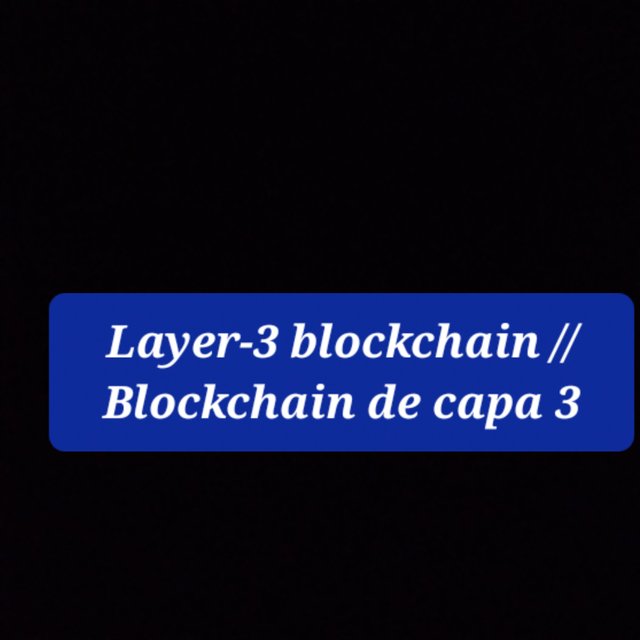SEC-S17/W2 | Layer-3 blockchain // Blockchain de capa 3

A
| Describe the architecture of layer 3 blockchains specialized in fractal scalability, highlighting the main components and mechanisms that achieve this objective. Create a chart that illustrates this architecture. |
|---|
Layer 3 blockchains specialized in fractal scalability typically employ a hierarchical structure with multiple layers of interconnected networks. At the core of this architecture are three main components: the base layer, the intermediate layer, and the application layer.
Base Layer:
This is the foundational layer of the blockchain network, responsible for consensus mechanisms, security, and maintaining the main ledger. It typically utilizes a highly secure and efficient consensus algorithm such as proof of stake (PoS) or delegated proof of stake (DPoS). The base layer ensures the overall integrity and security of the blockchain network.
Intermediate Layer: This layer acts as a bridge between the base layer and the application layer. Its primary function is to handle transaction processing and validation at scale. To achieve fractal scalability, the intermediate layer employs sharding techniques, where the network is divided into smaller, more manageable subsets called shards. Each shard operates semi-autonomously, processing a subset of transactions while still being interconnected with the rest of the network. This allows for parallel transaction processing and significantly increases the throughput of the blockchain network.
Application Layer:
This layer is where decentralized applications (DApps) and smart contracts reside. It provides the interface for developers to build and deploy their applications on the blockchain network. The application layer leverages the scalability provided by the intermediate layer to support a wide range of use cases and decentralized services.
In addition to these core components, layer 3 blockchains specialized in fractal scalability incorporate mechanisms such as:
Dynamic Shard Adjustment:
The network dynamically adjusts the number and size of shards based on demand and network conditions, ensuring optimal resource utilization and scalability.
Cross-Shard Communication: Mechanisms are implemented to facilitate communication and interoperability between different shards, allowing for seamless interaction between decentralized applications and transactions across the network.
Hierarchical Structure: The architecture is designed in a hierarchical manner, with each layer building upon the capabilities of the layer below it. This allows for modular scalability and efficient resource allocation.
Governance Mechanisms:
Robust governance mechanisms are implemented to ensure the integrity, security, and evolution of the network over time, including mechanisms for protocol upgrades, dispute resolution, and consensus rule changes.
Here's a simplified chart illustrating the architecture:
+------------------+
| Application Layer|
+------------------+
|
+------------------+
| Intermediate Layer|
+------------------+
|
+------------------+
| Base Layer |
+------------------+
This hierarchical structure allows for efficient scalability while maintaining security and decentralization.
| How do layer 3 blockchains specializing in fractal scalability use horizontal sharding to improve transaction processing capacity, and how does this differ from the Steem blockchain approach? |
|---|
Layer 3 blockchains that specialize in fractal scalability typically use horizontal sharding to partition the network into smaller, more manageable pieces called shards. Each shard operates independently, processing a subset of transactions. This approach improves transaction processing capacity by allowing multiple shards to process transactions concurrently, thereby increasing overall throughput.
The difference from the Steem blockchain approach lies in the implementation of horizontal sharding. While both approaches aim to improve scalability, the specifics of how they shard the network and handle transaction processing can vary significantly. Steem primarily uses a delegated proof-of-stake (DPoS) consensus mechanism, where a fixed number of block producers validate transactions for the entire network. In contrast, layer 3 blockchains specializing in fractal scalability may use more sophisticated sharding techniques, such as dynamic sharding or adaptive partitioning, to dynamically adjust shard sizes based on network demand and activity levels. Additionally, the consensus mechanism and incentive structures may differ between these blockchains, affecting how transactions are processed and validated within each shard.
| Explain how sidechains and rollups are essential elements of layer 3 blockchains to ensure fractal scalability, and how these concepts could be applied to the Steem blockchain to improve its performance |
|---|
Sidechains and rollups are crucial components of layer 3 blockchains because they help achieve fractal scalability by offloading transactions from the main chain to secondary chains or layers.
Sidechains allow for parallel processing of transactions by creating separate chains that are interoperable with the main chain. This reduces congestion on the main chain and improves overall scalability. Rollups, on the other hand, bundle multiple transactions into a single transaction, reducing the number of on-chain operations and thus increasing throughput.
Applying these concepts to the Steem blockchain could improve its performance by alleviating congestion and reducing transaction costs. For example, implementing sidechains could allow for the execution of smart contracts or other complex operations off the main chain, while rollups could bundle numerous Steem transactions into a single transaction, decreasing the burden on the main chain and improving overall efficiency. This would enhance the user experience and make the platform more scalable for future growth.
| How do Layer 3 blockchains handle the challenges of decentralized governance while maintaining fractal scalability, and how does this compare to the governance structure of the Steem blockchain? |
|---|
Layer 3 blockchains typically handle decentralized governance by implementing mechanisms such as liquid democracy, quadratic voting, or token-weighted decision-making. These systems aim to ensure fair participation and representation while allowing for efficient decision-making. Fractal scalability is achieved through techniques like sharding, which enables parallel processing of transactions across multiple chains or shards.
Comparing this to the governance structure of the Steem blockchain, Steem relies heavily on stake-weighted voting, where stakeholders can vote for witnesses who validate transactions and contribute to network governance. However, Steem has faced criticism for its perceived centralization of power among a few large stakeholders and the potential for vote manipulation. Layer 3 blockchains often strive to address these issues by introducing more sophisticated governance models that prioritize decentralization and inclusivity.
| How could the introduction of new technologies such as sharding and interoperable blockchains influence the future of layer 3 blockchains specialized in fractal scalability, and how could the Steem blockchain adapt to these developments? |
|---|
The introduction of sharding and interoperable blockchains could greatly enhance the scalability and interoperability of layer 3 blockchains, making them more efficient and versatile. In this context, Steem could adapt by exploring ways to integrate these technologies to improve its scalability and interoperability, potentially enhancing its ecosystem and attracting more users and developers. Additionally, Steem could focus on optimizing its infrastructure to leverage these advancements effectively, ensuring its relevance and competitiveness in the evolving blockchain landscape.
The Best: Regards:💗
@abdulhakeem786💥

Oh yeah, I've seen this hierarchical setup in action. It's like building a solid foundation for a skyscraper, with each layer adding strength and functionality. My experience with such structures taught me that organization is key for efficiency.
This reminds me of when I organized my garage into sections for tools, gardening, and sports gear. Each section operates independently, but they're all connected and accessible from the main area. Sidechains are like that, keeping things organized and efficient.
As a tech enthusiast, I'm excited about these advancements. It's like upgrading from a bicycle to a sports car, gaining speed and flexibility. I think embracing these innovations could open up new possibilities and make blockchain technology even more impactful.
All the best
Your comment has been successfully curated by, @kouba01 at 15%.
Oh yes! For Steem to keep up with the latest blockchain trends, it could try out this thing called sharding and interoperable blockchains as these technologies can help Steem be more efficient, work better with other blockchains, and handle more stuff at once. It could make Steem even more awesome and attract more people to join in. But then, the Steem infrastructure and ecosystem has to be top-notch to make the most of these advancements. It's all about staying relevant and competitive in the ever-changing world of blockchain.
Thank you for sharing your elaborate knowledge on this topic with all of us. Good luck in the contest.
You're absolutely right! Implementing technologies like sharding and interoperable blockchains could indeed enhance Steem's efficiency and scalability, making it more attractive to users and developers alike. It's crucial for Steem to stay on the cutting edge to remain competitive in the rapidly evolving blockchain landscape.
Saludos cordiales estimado amigo abdulhakeem786, un gusto para mi saludarte y leer tu participación en este reto, muchas gracias por la invitación.
Las cadenas laterales de capa 3, son soluciones escalables que brindan mejoras al las Blockchain de capa 1, estas estan estructuras para funcionar en base a su inspiración, es decir a las L1, pues de ellas dependen su seguridad.
Feliz y bendecido día.
Saludos cordiales. Es un placer saludarte también y agradezco tu participación en el reto. Las cadenas laterales de capa 3 son, de hecho, una innovación que amplía las capacidades de las blockchains de capa 1, ofreciendo mejoras en escalabilidad y funcionalidad. Su diseño se inspira en las características de las L1, ya que su seguridad depende de ellas. ¡Que tengas un día feliz y bendecido también!
x
https://x.com/abulhakeem888?t=E-J3VwtnyE1idEJUQrebpA&s=09
Sidechains and rollups are imaginative blockchain advances that support the versatility of Layer 3 blockchains, adding to fractal adaptability. Sidechains are free blockchains associated with the fundamental chain through spans, disseminating the computational burden and offering customized answers for explicit use cases. In correlation, rollups process numerous exchanges off-tie and submit synopses to the principal chain, upgrading throughput and diminishing dormancy. By using sidechains and rollups, Layer 3 blockchains can accomplish fractal adaptability, taking into account boundless exchanges without compromising execution. Carrying out these advancements on the Steem blockchain could work on its proficiency and adaptability. Sidechains could offload explicit capabilities to resemble chains, lessening the weight on the primary blockchain, while rollups could deal with a higher volume of exchanges all the more productively. This approach lines up with the developing pattern of complex blockchain environments, offering an adaptable, flexible, and future-evidence answer for the Steem blockchain.
Upvoted. Thank You for sending some of your rewards to @null. It will make Steem stronger.
AoA kasay ho app asa karo mare sat instagram pay conteact karo apko pay post k hawaly sa guide karta ho .. again apna buhet bare mistake keya hay.. asa apka leya malsa ban jay ga :
https://www.instagram.com/hamza_yousafzaii/
W.S sir ap humara lya qabla ahtram ha 😌 hum ap ki bhot respct karta ha agar koi ghalty ho jaya to ao pleas ap muja guid kraa ya mara face book h ap muj sa bat kar sakta ha https://www.facebook.com/profile.php?id=100076176792569&mibextid=ZbWKwL
Pleas contact me.😌
Hello good friend I really enjoy your article I must say you are really specially because I love your unique content and the unique. This makes you so outstanding and very attractive you Really did well keep it up. Good advice I would give you that might help you spice up your content is, you should ensure you answer every question from the contest I believe this would increase our chances of getting higher great.
Thank you very much friend for going through all the difficulties and stress just to come up with this quality article, on your free time I will appreciate you dropping a comment on my entry to the link below https://steemit.com/hive-108451/@starrchris/sec-s17-w2-or-or-layer-3-blockchain
Hello friend greetings to you, hope you are doing well and good there.
You have beautifully explained all the layers of Blockchain. The graph you have drawn is amazing. You said that in Blockchain scalability is achieved through sharding process which is very much true.
sidechains and rollups are explained very well and yes these two are very much important for layer 3 blockchains. Your post is amazing dear friend, you have made a nice attempt.
I wish you very best of luck in this contest.